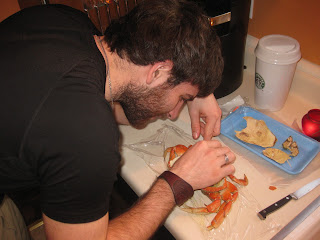My littlest brother has been in town for the last two weeks on his way to an adventure. I just dropped him off at the airport this morning for his flight to Alaska where he will be living for the next 4 months. We did lots of fun things while he was here, hiking, shopping, going out to eat, watching football etc. We also (my idea) bought a Dungeness crab from the grocery store to dissect on my kitchen counter one afternoon. It was really fun. We probably weren't as careful as a real carcinologist, and our tools were much more primitive, but it was still fun and really interesting. We were able to get a closer look at the mouth, gills, and reproductive apparatus. And although we never did find the heart, we discovered two glands(?) that look like bunched up spaghetti in the inner most reaches of the carapace. Yummm.
In preparation for our dissection I did a little reading up on Dungeness crabs, and learned some really interesting things. (For a more complete description click here for the paper by the US Fish and Wildlife Services.) Here are a few fun facts I thought I'd share:
Dungeness Crab:
Scientific name: Cancer magister DanaHabitat: Off the coast of Central California to the Gulf of Alaska
 |
| Zoea |
- Only male crabs are allowed to be caught for commercial sale.
- A female can lay up to 5 million eggs in her lifetime, with each brood producing 1 to 2 million eggs!
- Baby crabs spend the first portion of their lives as zoea and float around in the ocean currents like plankton. They are tiny (about the size of the tip of a pencil) and don't look anything like a crab, with a beak and giant eyes.
- Dungeness crabs are some of the most "meaty" crabs with approximately 25% edible parts by weight.
- When crabs molt, the shed their entire shell including eye stalks and claws. For a neato time lapse video of a crab molting (and mating click here.)
Here are a couple photos from our dissection! Enjoy!!!
 |
| Reproductive gonopods (male) |
 |
| Jay carefully removing shell |
 |
| Mouth with feeder arms |
 |
| Portion of gill with feather like membranes |


No comments:
Post a Comment